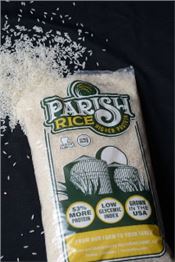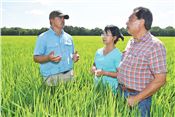LSU AgCenter Research Into Low-GI, High-Protein Rice Expanding Amid Regional Demand Spike
DEREK ALBERT
CROWLEY, LOUISIANA
As more Gulf Coast consumers learn of the potential benefits of locally grown high-protein, low-glycemic index rice, researchers at the LSU AgCenter’s H. Rouse Caffey Rice Research Station are expanding efforts to develop cultivars with even greater nutritional advantages.
Two scientists – molecular geneticist Herry Utomo, the F. Avalon Daggett endowed professor, and biotechnologist Ida Wenefrida, associate professor – spent seven years developing the special rice cultivar released under the variety moniker, Frontière. Now, using traditional mutational rice breeding techniques, they hope to further improve protein content, yield output and market diversity.
Until now, the ubiquitous grain crop typically contained 6-7 percent protein. Frontière contains 10.6 percent, Wenefrida said. The next echelon the pair hopes to reach is 12 percent protein, which would mark a 100-percent protein increase over traditional cultivars.
“In order to serve more diverse market needs, we are now expanding our breeding efforts to include other rice types aimed to increase yield potential while keeping the GI score low,” Utomo said.”
Two advanced rice lines are in the pipeline. One long grain and one medium grain are developed for the southern U.S. rice growing regions.
Another medium grain rice, better suited for growing in areas such as California, is also in development.
While the researchers spent seven years developing the Frontière variety, Utomo said there are recently identified shortcuts that can be integrated into breeding techniques to speed the breeding process.
“A specific selection index with three key determinants is being used in low-GI selection schemes in parallel to high-protein screening,” Utomo said.
The pair says Frontière has global nutritional payoffs. Utomo touts the low-GI trait for adding more nutritional variety to the diets of people with diabetes. He said diabetes is affecting more than 37.3 million Americans (11.3 percent of the U.S. population) and is the seventh leading cause of death. Globally, over 537 million adults (20-79 years-old) are living with diabetes and causing 6.7 million deaths annually. Rice, in general, has a GI score of 73 which earns it a “high-GI food” designation. The Frontière cultivar has a GI score of 41, which falls under the “low-GI food” category.
“This is a game changer,” Utomo said. “…not only for people with diabetes, but also for people with pre-diabetes who need to prevent the condition from progressing into a full stage of diabetes.”
While the benefits of high-protein, low GI rice are evident in domestic markets, there are also benefits for developing nations abroad. Wenefrida said the greatest benefit of having more protein in rice is in alleviating malnutrition problems. This payoff could be especially important for areas where infancy mortality rates are directly correlated with malnutrition levels.
“Chronic malnutrition has affected children around the world with the stunting rate of 21 percent,” she explained. “Rice is a gentle baby food ingredient. The low-GI, high-protein rice can be used to fight chronic malnutrition affecting 21 percent of children around the world.”
It is not just infants who can benefit from the nutritional advantages of low-GI, high-protein rice. Rice is lean, plant-based protein source which is a good dietary component to help develop healthy lipid profiles. The non-GMO, naturally gluten-free cultivar can help other demographics curb consumption of cholesterol-laden animal protein sources.
“Vegetarians can benefit also from this rice by having an additional 50% of plant-based protein per serving,” Wenefrida said.
As popularity of Frontière rice grows across the Gulf Coast, more and more retailers are finding shelf space for the product. Parish Rice, grown and marketed by Eunice, La.-based Fruge Farms can be found in several grocery stores including NuNu’s Markets in the central Acadiana area; Fresh Pickins in Lafayette; Rouse’s Supermarkets throughout Louisiana and Mississippi; and in H-E-B Supermarkets throughout Texas. Frontière is also sold under the label, Cahokia in Midwest markets. That product, identical to Parish Rice, is grown in Illinois.
The LSU AgCenter research behind low-GI, high-protein rice is funded, in part, by the LSU Leveraging Innovation for Technology Transfer grant, also known as LIFT2. Other funding sources include Louisiana rice farmers themselves – in the form of checkoff funds collected by the Louisiana Rice Research Board. ∆
DEREK ALBERT: LSU AgCenter

LSU AgCenter molecular geneticist Herry Utomo shares the latest developments of low-GI, high-protein rice during the 2021 Rice Field Day. This year, Utomo and staff at the H. Rouse Caffey Rice Research Station are working to increase yield potential and protein content in the variety – Frontière.
Photo by Derek Albert/LSU AgCenter

Parish Rice, grown and marketed by Eunice, La.-based Fruge Farms can now be found on supermarket shelves throughout the Central Gulf Coast Region. The low-GI, high- protein rice brand is milled at the Falcon Rice Mil, located in Crowley, La.
Photo Courtesy of Parish Rice

Eunice, La.-based rice farmer Mike Fruge (left) discusses rice development with Frontière's developers Ida Wenefrida and Herry Utomo.
Photo by Bruce Schultz